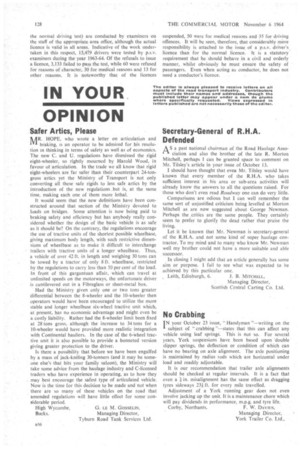IN YOUR OPINION
Page 130

If you've noticed an error in this article please click here to report it so we can fix it.
Safer Adios,. Please
MR. HOPE, who wrote a letter on articulation and "1 braking, is an operator to be admired for his resolution in thinking in terms of safety as well as of economics. The new C. and U. regulations have dismissed the rigid eight-wheeler, so rightly mourned by Harold Wood, in favour of articulation. In the trade we all know that rigid eight-wheelers are far safer than their counterpart 24-tongross attics yet the Ministry of Transport is not only converting all these safe rigids to less safe artics by the introduction of the new regulations .but is, at the same time, making each one of them more lethal. It would seem that the new definitions have been constructed around that section of the Ministry devoted to loads on bridges. Some attention is now being paid to braking safety and efficiency but has anybody really considered whether the design of the basic vehicle is as safe as it should be? On the contrary, the regulations encourage the use of tractive units of the shortest possible wheelbase, giving maximum body length, with such restrictive dimensions of wheelbase as to make it difficult to interchange trailers with tractive units of a longer wheelbase. Thus, a vehicle of over 42 ft. in length and weighing 30 tons can be towed by a tractor of only 8 ft. wheelbase, restricted by the regulations to carry less than 50 per cent of the load. In front of this gargantuan affair, which can travel at unlimited speeds on the motorways, the unfortunate driver is cantilevered out in a Fibreglass or sheet-metal box. Had the Ministry given only one or two tons greater differential between the 8-wheeler and the 10-wheeler then operators would have been encouraged to utilize the more stable and longer wheelbase six-wheel tractive unit which, at present, has no economic advantage and might even be a costly liability. Rather had the 8-wheeler limit been fixed at 28 tons gross, although the increase to 34 tons for a 10-wheeler would have provided more realistic integration with Continental hauliers. In the case of the 6-wheel tracfive unit it is also possible to provide a bonneted version giving greater protection to the driver. Is there a possibility that before we have been engulfed by a mass of jack-knifing 30-tonners (and it may be someone else's that hits your family saloon), the Ministry will take some advice from the haulage industry and C-licensed traders who have experience in operating, as to how they may best encourage the safest type of articulated vehicle. Now is the time for this decision to be made and not when there are so many of these vehicles on the road that amended regulations will have little effect for some considerable period. High Wycombe, 0. 'LE M. GOSSELIN, Bucks, Managing Director,
Tyburn Road Tank Services Ltd.
Secretary-General of R.H.A. Defended
AS a past national chairman of the Road Haulage Association and also the brother of the late R. Morton Mitchell, perhaps I can be granted space to comment on Mr. Tilsley's article in your issue of October 13. I should have thought that eves Mr. Tilsley would have known that every member of the R.H.A. who takes sufficient interest in his area or sub-area activities will already know the answers to all the questions raised. For those who don't even read Roadway one can do very little. Comparisons are odious but I can well remember the same sort of unjustified criticism being levelled at Morton Mitchell as are now suggested about George Newman. Perhaps the ,critics are the same people. They certainly seem to prefer to glorify the dead rather that praise the living. Let it be known that Mr. Newman is secretary-general of the R.H.A. and not some kind of super haulage contractor. To my mind and to many who know Mr. Newman well my brother could not have a more suitable artd able successor. In closing I might add that an article generally has some aim or purpose. I fail to see what was expected to be achieved by this particular one. Leith, Edinburgh, 6. J. 13, MITCHELL, Managing Director, Scottish Central Carting Co. Ltd.
No Crabbing
IN your October 23 issue, " Handyman "—writing on the A subject of " crabbing" states that this can affect any vehicle using leaf springs. This is not so. For several years, York suspensions have been based upon 'double slipper springs, the deflection or condition of which can have no bearing on axle alignment. The axle positioning is maintained by radius rods which are horizontal under load and readily adjustable. It is our recommendation that trailer axle alignments should be checked at regular intervals. It is a fact that even a in. misalignment has the same effect as dragging tyres sideways 231 ft. for every mile travelled. Adjustment of a York running gear does not even involve jacking up the unit. It is a maintenance chore which will pay dividends in performance, m.p.g. and tyre life. Corby, Northants. F. W. DAVIES,
Managing Director, York Trailer Co. Ltd.,












































































































































































